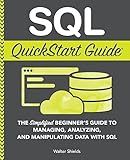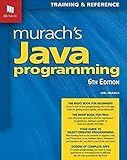Best Programming Guides to Buy in December 2025

Python QuickStart Guide: The Simplified Beginner's Guide to Python Programming Using Hands-On Projects and Real-World Applications (Coding & Programming - QuickStart Guides)



SQL QuickStart Guide: The Simplified Beginner's Guide to Managing, Analyzing, and Manipulating Data With SQL (Coding & Programming - QuickStart Guides)



Python Programming Language: a QuickStudy Laminated Reference Guide



Beginner's Step-by-Step Coding Course: Learn Computer Programming the Easy Way (DK Complete Courses)



Murach's Java Programming Book Complete Guide for Beginners & Advanced Developers - Self-Paced Learning with GUI, Database & Object-Oriented Programming - Professional Coding Skills (6th Edition)



Guide to Competitive Programming: Learning and Improving Algorithms Through Contests (Undergraduate Topics in Computer Science)



SQL Programming QuickStudy Laminated Reference Guide



C++ Programming Language QuickStudy Laminated Reference (Quickstudy Reference Guide)



HTML and CSS QuickStart Guide: The Simplified Beginners Guide to Developing a Strong Coding Foundation, Building Responsive Websites, and Mastering ... (Coding & Programming - QuickStart Guides)


The increment function in Laravel is used to increase the value of a specified column in a database table. This function takes two arguments - the first argument is the column name that you want to increment, and the second argument is the amount by which you want to increment the column's value.
To use the increment function in Laravel, you first need to retrieve the model instance that you want to update from the database using the find() method or any other method of your choice. Once you have the model instance, you can call the increment() method on it, passing in the column name and the increment value as arguments.
Here is an example of how you can use the increment function in Laravel:
$user = User::find(1); $user->increment('points', 10);
This code snippet will find the user with an ID of 1 in the users table and increase the value of the 'points' column by 10. The increment function will handle updating the database for you, so you don't need to worry about manually updating the column value.
How to increment a column value in a database transaction in Laravel?
To increment a column value in a database transaction in Laravel, you can use the DB facade along with the transaction method. Here's an example:
use Illuminate\Support\Facades\DB;
DB::transaction(function () { // Find the relevant record and increment the column value $record = Model::find($id); $record->column_name += 1; $record->save(); });
In this example, replace Model with the name of your model class, $id with the id of the record you want to update, and column_name with the name of the column you want to increment.
By using the DB::transaction method, Laravel will automatically handle the transaction for you, ensuring that all updates are either committed or rolled back if an error occurs.
Remember to handle any potential exceptions that may occur within the transaction block and rollback the transaction if needed.
What is the significance of using the increment function over raw SQL queries in Laravel?
Using the increment function in Laravel provides several advantages over raw SQL queries:
- Safety and security: The increment function takes care of properly escaping and sanitizing inputs, helping to prevent SQL injection attacks.
- Easier syntax: The increment function provides a more streamlined and cleaner syntax compared to writing raw SQL queries, making it easier to read and understand.
- Eloquent ORM integration: The increment function is natively supported by Laravel's Eloquent ORM, allowing for seamless integration with database queries in an object-oriented manner.
- Database agnostic: The increment function is designed to work across different database systems supported by Laravel, ensuring compatibility and consistency in your codebase.
Overall, using the increment function in Laravel helps to improve code quality, maintainability, and security compared to writing raw SQL queries.
What is the impact of using the increment function on database locking in Laravel?
In Laravel, the increment function is used to increment the value of a particular column in the database. When using the increment function, it typically performs a database update operation, which requires a database lock to ensure data integrity and prevent conflicts with other operations that may be trying to access or modify the same data.
The impact of using the increment function on database locking in Laravel is that it may lead to potential locking conflicts if multiple processes are trying to increment the same column simultaneously. This can result in delays, blocking, or deadlock situations where one process is waiting for another to release the lock before it can proceed.
To mitigate locking conflicts when using the increment function, it is important to use proper database transaction management techniques, such as using explicit transactions, optimizing queries, and minimizing the amount of time a lock is held. Additionally, considering using optimistic locking techniques, such as using timestamps or version numbers to handle concurrent updates more gracefully. Overall, it is important to carefully design your application's database interactions to minimize the risk of locking conflicts when using the increment function in Laravel.
How to increment a column value and retrieve the model instance in a single query in Laravel?
You can achieve this by using the update method in Laravel Eloquent, which allows you to update a column's value and retrieve the model instance in a single query. Here's an example that increments the column_name column by a specified value and retrieves the updated model instance:
// Find the model instance using a specific condition $model = ModelName::where('column_name', 'value')->first();
// Update the column value and retrieve the updated model instance $model = $model->update(['column_name' => $model->column_name + 1]);
// Now $model contains the updated instance with the incremented column value
How to increment a column value and return the updated value in Laravel?
You can increment a column value in Laravel using the increment method. Here is an example code snippet to demonstrate how to increment a column value and return the updated value:
use App\Models\User;
$user = User::find(1); // Find the user with ID 1
// Increment the column value by 1 $user->increment('points');
// Retrieve the updated value $updatedValue = $user->points;
return $updatedValue;
In this code snippet, we are incrementing the points column value of a user with ID 1 by 1 using the increment method. We then retrieve the updated value and return it.
